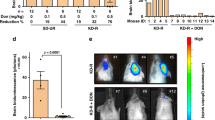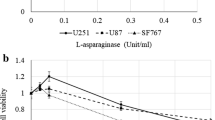Abstract
We have previously shown that diet restriction-induced depletion of large neutral amino acids (LNAAs) in murine plasma to 46% of control significantly enhances intracranial delivery of melphalan without enhancing delivery to other organs. Studies have now been conducted to determine whether more substantial LNAA depletion could further enhance intracranial delivery of melphalan. Treatment with Lamino acid oxidase (LOX) significantly depleted murine plasma LNAAs: phenylalanine, leucine, and tyrosine (>95%); methionine (83%); isoleucine (70%); and valine (46%). Experiments evaluating the intracellular uptake of melphalan and high-pressure liquid chromatography quantitation of melphalan metabolites revealed, however, that melphalan is rapidly degraded in the presence of LOX, and that the timing of the administration of melphalan following the use of LOX to deplete LNAAs is crucial. Conditions were found under which LOX-mediated degradation of melphalan was minimized and LNAA depletion was maximized, resulting in a potentiation of the antitumor effect of melphalan on human glioma xenografts in nude mice. Such potentiation could not be obtained using diet restriction alone.
Similar content being viewed by others
References
Bergel F, Stock JA (1953) Cytotoxic alpha amino acids and endopeptides. Br Emp Cancer Camp Annu Rep 31: 6
Bullard DE, Schold SC Jr, Bigner SH, Bigner DD (1981) Growth and chemotherapeutic response in athymic mice of tumors arising from human glioma-derived cell lines. J Neuropathol Exp Neurol 40: 410
Christensen HN (1990) Role of amino acid transport and countertransport in nutrition and metabolism. Physiol Rev 70: 43
Cornford EM, Young D, Paxton JW, Finlay GJ, Wilson WR, Pardridge WM (1992) Melphalan penetration of the bloodbrain barrier via the neutral amino acid transporter in tumorbearing brain. Cancer Res 52: 138
Daniel PM, Love ER, Moorhouse SR, Pratt OE (1981) The effect of insulin upon the influx of tryptophan into the brain of the rabbit. J Physiol 312: 551
Friedman HS, Colvin OM, Ludeman SM, Schold SC Jr, Boyd, VL, Mulhbaier LH, Bigner DD (1986) Experimental chemotherapy of human medulloblastoma with classical alkylators. Cancer Res 46: 2827
Friedman HS, Schold SC Jr, Mahaley MS Jr, Colvin OM, Oakes WJ, Vick NA, Burger PC, Bigner SH, Borowitz M, Halperin EC, Djang W, Falletta JM, DeLong R, Garvin JH, DeVivo DC, Norris D, Golembe B, Winter J, Bodziner RA, Sipahi H, Bigner DD (1989) Phase II treatment of medulloblastoma and pineoblastoma with melphalan: clinical therapy based on experimental models of human medulloblastoma. J Clin Oncol 7: 904
Fukagawa NK, Minaker KL, Young, VR, Rowe JW (1986) Insulin dose-dependent reductions in plasma amino acids in man. Am J Physiol 250: E13
Giard DJ, Aaronson SA, Todaro GJ, Arnstein P, Kersey JH, Dosik H, Parks WP (1973) In vitro cultivation of human tumors: establishment of cell lines derived from a series of solid tumors. J Natl Cancer Inst 51: 1417
Glaeser BS, Maher TJ, Wurtmann RJ (1983) Changes in brain levels of acidic, basic, and neutral amino acids after consumption of single meals containing various proportions of protein. J Neurochem 41: 1016
Greig NH, Momma S, Sweeny DJ, Smith QR, Rapoport SI (1987) Facilitated transport of melphalan at the rat blood-brain barrier by the large neutral amino acid carrier system. Cancer Res 47: 1571
Greig NH, Sweeny DJ, Rapoport SI (1988) Comparative brain and plasma pharmacokinetics and anticancer activities of chlorambucil and melphalan in the rat. Cancer Chemother Pharmacol 21: 1
Groothuis DR, Lippitz BE, Fekete I, Schlageter KE, Molnar P, Colvin OM, Roe CR, Bigner DD, Friedman HS (1992) The effect of an amino-acid lowering diet on the rate of melphalan entry into brain and xenotransplanted glioma. Cancer Res 52: 5590
Horowitz ME, Etcubanas E, Christensen ML, Houghton JA, George SL, Green AA, Houghton PJ (1988) Phase II testing of melphalan in children with newly diagnosed rhabdomyosarcoma: a model for anticancer drug development. J Clin Oncol 6: 308
Miller LP, Pardridge WM, Braun LD, Oldendorf WH (1985) Kinetic constants for blood-brain barrier amino acid transport in conscious rats. J Neurochem 45: 1427
Pardridge WM (1983) Brain metabolism: a perspective from the blood-brain barrier. Physiol Rev 63: 1481
Pardridge WM (1987) Phenylalanine transport at the human blood-brain barrier. In: Kaufman S (ed) amino acids in health and disease: new perspectives. Alan R. Liss, New York, pp. 43–64
Pardridge WM, Choi TB (1986) Neutral amino acid transport at the human blood-brain barrier. Fed Proc 45: 2073
Pardridge WM, Mietus LJ (1982) Kinetics of neutral amino acid transport through the blood-brain barrier of the newborn rabbit. J Neurochem 38: 955
Pritchard J, McElwain TJ, Graham-Pole J (1982) High-dose melphalan with autologous marrow for treatment of advaned neuroblastoma. Br J Cancer 45: 86
Shamoon H, Jacob R, Sherwin RS (1980) Epinephrine-induced hypoaminoacidemia in normal and diabetic human subjects: effect of beta blockade. Diabetes 29: 875
Singer TP, Kearney EB (1950) Thel-amino acid oxidases of snake venom. II. Isolation and characterization of homogeneousl-amino acid oxidase. Arch Biochem 29: 190
Smith JP, Rutledge F, Warton JT (1972) Chemotherapy of ovarian cancer. New approaches to treatment. Cancer 1: 1565
Smith QR, Momma S, Aoyagi M, Rapoport SI (1987) Kinetics of neutral amino acid transport across the blood-brain barrier. J Neurochem 49: 1651
Takada Y, Greig NH, Vistica DT, Rapoport SI., Smith QR (1991) Affinity of antineoplastic amino acid drugs for the large neutral amino acid transporter of the blood-brain barrier. Cancer Chemother Pharmacol 29: 89
Tan NH, Saifuddin MN (1991) Substrate specificity of king cobra (Ophiophagus hannah) venoml-amino acid oxidase. Int J Biochem 23: 323
Wellner D, Meister A (1960) CrystallineL-amino acid oxidase ofCrotalus adamanteus. J Biol Chem 235: 2013
Author information
Authors and Affiliations
Rights and permissions
About this article
Cite this article
Rich, J.N., Elion, G.B., Wellner, D. et al. The effect ofl-amino acid oxidase on activity of melphalan against an intracranial xenograft. Cancer Chemother. Pharmacol. 36, 379–384 (1995). https://doi.org/10.1007/BF00686186
Received:
Accepted:
Issue Date:
DOI: https://doi.org/10.1007/BF00686186




